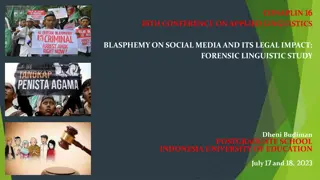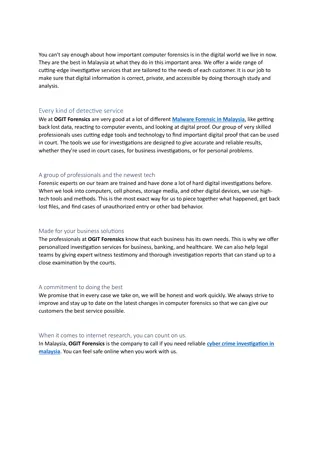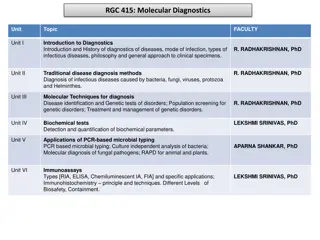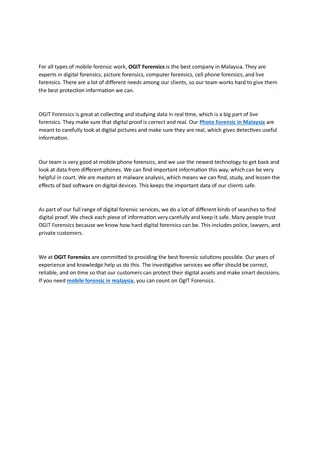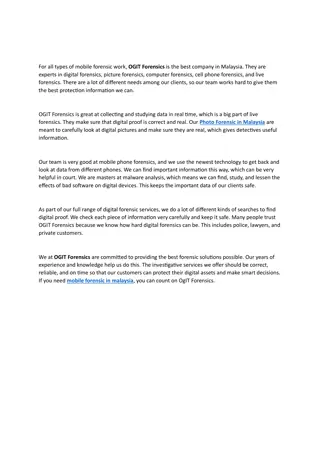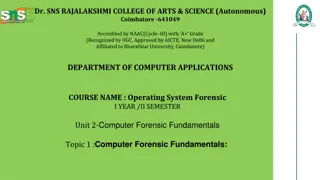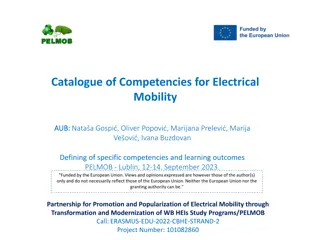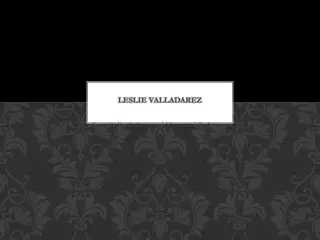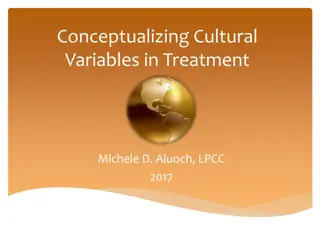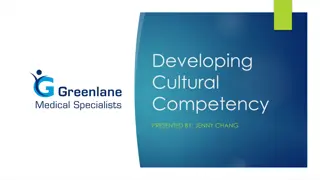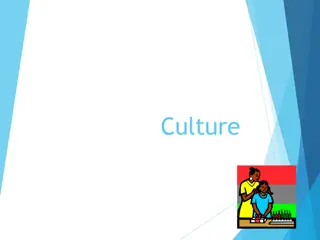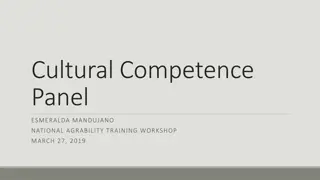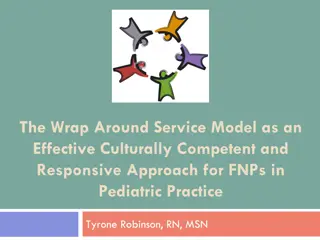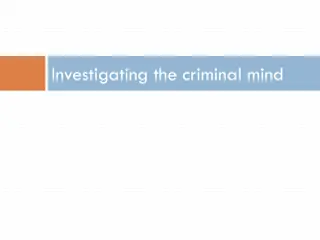H.E.A.T. Program in Forensic Treatment: Enhancing Cultural Competence
In forensic treatment settings, the H.E.A.T. program, focusing on minority males in the criminal justice system, employs a holistic approach to therapy that emphasizes habilitation, empowerment, accountability, and therapy. Developed by Daryl Turpin, the program addresses cultural barriers through culturally specific treatment, promoting recovery and well-being among those with addiction and mental health issues.
Download Presentation

Please find below an Image/Link to download the presentation.
The content on the website is provided AS IS for your information and personal use only. It may not be sold, licensed, or shared on other websites without obtaining consent from the author. Download presentation by click this link. If you encounter any issues during the download, it is possible that the publisher has removed the file from their server.
E N D
Presentation Transcript
Applications of H.E.A.T. in Forensic Treatment Settings Enrique Morris | Javier Davila-Lopez, LPC Jessica Minor, LPC-Associate | Jessica Simmons, LPC, LCDC
IPS Recovery Organization Overview Outpatient Behavioral Health Provider Providing behavioral health services to indigent, forensically involved individuals Dedicated to addressing the underlying causes of addiction & mental health issues with the latest Evidenced Based Practices (EBPs)
Treatment Approach Collaboration with community partners and court systems We offer supervised outpatient treatment programs provided by licensed clinicians Treatment modalities include group, individual, family counseling, and medication assisted treatment In-person and telehealth treatment options are available
Explore Cultural Competence vs. Culturally Specific Treatment H.E.A.T. Program Development H.E.A.T. vs Traditional Approaches Agenda IPS H.E.A.T. program initiation Explore the H.E.A.T. Structure Fidelity modifications made by IPS
WHAT IS CULTURAL COMPETENCE? The ability to provide therapy that can overcome cultural barriers that may exist between the therapist and the patient.
WHAT IS CULTURE SPECIFIC TREATMENT? The application of culturally sensitive screening and assessment instruments, and therapeutic curriculum.
H.E.A.T. Program Overview What is H.E.A.T. ? Habilitation Empowerment Accountability Therapy a therapy program designed for minority males, ages 18-29 who are involved in the criminal justice system H.E.A.T. applies a holistic, culturally relevant and responsive, strength-based model that emphasizes a positive and engaging approach to treatment (Turpin, D. & Wheeler, G., 2013).
Developers of H.E.A.T. Daryl Turpin, MPA (Masters in Public Administration in Human Resource Management), Bachelors of Clinical Social Work, CADC (Certification of Alcohol & Drug Counselor?): Coordinator for Dept Health & Wellness, Chairperson for PAL (Police Activities League) in in Kentucky Guy Wheeler, MSW (Masters of Social Work), CAP (Certified Addictions Professional), CCJAP (Certified Criminal Justice Addictions Professional)
Use of culturally-relevant verbiage H.E.A.T. vs Traditional Interventions Emphasis of Spirituality Principles Organized into 3 Categories No provision of SUD specific psychoeducation
H.E.A.T. Program Initiation at IPS There is an overrepresentation of minorities who are involved in the criminal judicial system Minorities (i.e., Black and Latino) make up approx. 31% of the US population, yet account for 68.6% of incarcerated individuals. In 2019, IPS was called upon by the Dallas County DA s office to collaborate and implement a culturally specific treatment intervention for a targeted population of minority males. H.E.A.T. program initiation at IPS began in February 2020.
H.E.A.T. PROGRAM STRUCTURE
Program Structure: Self Self: Is a section built around understanding self, core beliefs, attitudes, and thinking errors/patterns. Manhood: Speaks directly to understanding of self-view and standard to which we will hold each other accountable while in the program. (core beliefs and expectations)
Program Structure: Self Continued High Cost of Low Living: is teaching cost benefits analysis. Structured in a way that helps the participants understand not just the financial cost of decisions but that there is also a cost to your physical health, family, school/work, legal, and spiritual aspects of life. Messed up thinking: my thinking is just messed up discusses thinking errors Hip Hop: is used as a means of explaining self-expression as well as understanding how outside influences can shape our perceptions.
Program Structure: Family Family: section in general is also teaching how to be empathetic and see the affect our behavior has on other people. Baby Momma Drama: address the topics of co-parenting but initially presents the issues with terms the young men know of more readily. Fatherhood: what does it mean to be present in a child s life. Providing means more than just financial aid.
Program Structure: Family Continued Love or Lust: is about breaking down how one s own decisions to have sex without fear of consequence or ability to raise a child can affect not just themselves but entire communities. Generations of single parent households have a negative impact on the community they live in.
Program Structure: Community Community: This section focuses on the importance of advocacy and community involvement. We highlight the impact the community can have on the individual and how the participants can leave a positive impact on their community as well. My Hood: Prompts the participants to look deeper into their neighborhoods and see what strengths and opportunities their neighborhood offers as well as the challenges and barriers it may produce.
Program Structure: Community Continued Root Causes: Focuses on the where some of the challenges and barriers in the participants neighborhoods originate from. The participants will look at the prevailing issues in their communities and either, research an organization that is trying to have a positive impact in that area of concern, or brainstorm solutions that could resolve the problem they have identified.
Program Structure: Community Continued Healing Voices: This project serves as a way to teach the participants what it means to be an advocate. The participants will research their chosen topic of concern in their community and ways to resolve it. This includes speaking to city council members, starting a nonprofit, setting up a charity, anything and everything that could be done to support and advocate for their community. The participants will create a presentation and then speak to their community leaders about their topic.
CHALLENGES IN IMPLEMENTATION
Challenges Experienced Through Implementation At risk to not complete court program due to Moderator Variables Implementation according to Evidence Based Practices for Standard IOP vs. H.E.A.T. structure Need to fulfill other court requirements while engaging in an intensive treatment program Training multiple staff so that Co-facilitation possible Living in a low-income area Raised by a single mother Not completing high school or obtaining a GED 10 hours of service per week vs. 3 hours 8 hours of orientation prior to group initiation Intended to be a Closed Group Referrals trends dependent on external partners Initiating a new treatment program during COVID-19
FIDELITY MODIFICATIONS
How we adapted H.E.A.T. to align with EBPs Program is offered three days per week instead of two. Sometimes allowing non-minority participants in the group. Open Group format During the 3rd day of HEAT each week, Clinician incorporates information from the SSC Curriculum and Seeking Safety Curriculum, and other EBP material to provide psychoeducation on SUD issues.
SUCCESSES IN TREATMENT
Successes in Treatment Maintaining engagement with patients leading to higher show rates & lower rate of attrition 75% overall show rate to groups 39 total participants served to date 23 total participants still active External partners / treatment team member also being trained in HEAT so that messages are reinforced across the Multi-disciplinary Team
Clinician Observations & Testimonials Patient Growth and changes while in the program Patient Reflections: At first I wasn t messing with this but after a few days I learned that sometimes you need to talk about your problems with people with similar problems to come to peace with them and overcome them. My experience with the HEAT program has been well. I ve learned a good amount of thins that will help me be able to change my community and that can help me stay sober. I learned to open up about my negative thoughts, that I hold in on the inside, and meet great people that go through similar situations.
Clinician Observations & Testimonials Patient Reflections: At first I didn t think I would like it because I didn t really like my other group a lot but, I like how in this one we can be more communicative and more open. Heat chilled me out when at first I wasn t messing with it because I thought it was pointless. My experience with HEAT has been great, it gives you the opportunity to express yourself, and it allows you to be yourself. What I like about HEAT is I can actually open up and express how I feel and get great feedback. My experience with HEAT has been helpful in the sense of seeing others and heating stories and problems. Also, HEAT allowed me to hear advice that I may have not received otherwise. What I like about heat is that it gives me different ways to deal with a situation, and we can vent about our problems. HEAT is the best part of the program because I get to talk to someone about the problems I have in my life. Before I would have just to hold them in.
WHAT ARE WE LOOKING TO ACHIEVE IN THE FUTURE?
Future Considerations Continue to provide culturally competent curriculum to lower income or under privileged young minority males. To increase drug court participation success rate and reduce the recidivism rate of minority men. Accurately assess efficacy for HEAT program and other IOP programs. H.E.A.T has known possible limitations on of it not being an empirically validated model, & we hope our use of the curriculum can be incorporated into future studies. Emphasize that culturally competent curriculum is needed and is EBP. Hopefully aiding in the development of more culturally competent curriculum not just for minority males.
Thank you! IPSRecovery.com



